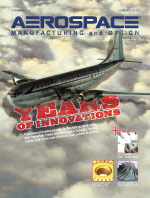Column From: Aerospace Manufacturing and Design- June/July 2010
Edited by: Matthew Grasson, Associate Editor
Putting out good products, and being profitable, is what it is all about in the machining business. Companies strive to become more efficient with their resources, always watching the bottom line. But, what happens when quality control becomes the bottleneck that is wasting time and money while pinching an already thin profit margin?
Many precision machine part manufacturer’s find this scenario is often the case, as did American Turned Products (ATP), Fairview, PA until the company started using the OASIS Inspection System, manufactured in Middletown, DE
The entire article can be read below.
Many precision machined part manufacturer’s find this scenario is often the case, as did American Turned Products (ATP), Fairview, PA, until the company started using the OASIS Inspection System, manufactured by Middletown, DE-based George Products Co.
ATP is a third-generation family-owned business that started in Erie, PA, in 1984. “Since our inception in 1984,” says Jerry Eighmy, president, ATP, “American Turned Products has continuously invested in its people and very sophisticated machining systems. Our advanced equipment enables us to produce very complex machine components used worldwide.”
During the past 26 years, ATP’s commitment to excellence has allowed the business to grow, expanding its operations to two plants in Erie County, PA.
As a high-volume contract precision machining manufacturer, ATP specializes in the machining of millions of complex components used in the automotive, fluid power, aerospace, medical, and other diverse markets. “We operate the most sophisticated machines in the world. All of our equipment is designed to be flexible to allow us to serve diverse markets. We can supply parts for any number of different industries and be cost competitive,” says ATP’s Chief Executive Officer, Scott Eighmy.
Harry Eighmy, ATP’s chief operating officer, is well aware of what it takes to be successful in today’s business climate, “Lean manufacturing, process controls, and mistake-proofing allow us to exceed our customer’s demands. We look for any opportunity to take cost out of what we are doing and share those savings with our customers.”
Julian Torres, quality manager for ATP, knows that machine downtime means lost money. “If our machines are not running and producing quality parts, then we are directly losing the income potential and profits from the machine downtime,” Torres says. “When we initiate a product changeover on a machine, the longer it takes the more money it costs. One of our biggest factors in reducing setup time is minimizing the time required to verify the changeover. Quality control verification is required to approve the first-run parts before production can start, so a slower inspection process can mean dollars down the drain.
“But, that is not the only place where inspections can cost us money,” Torres adds. “It is also with in-process inspections performed by our machine operators.” The longer it takes to complete an in-process inspection, the higher potential for larger quality spills due to operator attention away from the actual machining process. Clearly, faster inspection means you can do more in-processes inspection during a shift, allowing processes to be monitored much closer, minimizing our risk for producing non-conforming parts and having to perform a potential 100% sort.”
Timely Solution
Nobody likes to sort buckets full of parts, good from bad, but most shops have to do it every once in a while, and time is of the essence when sorting parts, as it is with most things in a fast-paced production machining environment. Consider the fact that while inspecting parts, employees are taken away from other critical tasks. For example, if a machine operator is taking time for slow in-process inspections, he does not have that time to monitor the process of making chips on his machine. In some cases, ATP found that operators simply could not keep up with the time demands of slow inspection processes while running their machines.
“We needed a solution to the problem of slow inspection. To ensure that we are always shipping quality parts, we need an inspection system that is both accurate and repeatable. But, that is not all; we need the inspection system to be fast, to make a quality product, sold at a competitive price, while still making a profit for the business. It is critical that we get the increased efficiency and cost savings from an inspection system that is fast enough to keep up with production demands and save us money,” Torres explains. “We found that solution in the OASIS Inspection System.”
The OASIS Inspection System is a machine-vision system that creates a shadow of small parts, and then measures every dimension on that image at the same time, all to a repeatable accuracy of ±0.0001″. Measurements are instantly compared against process control limits and tolerances, with an immediate visual display of whether any and all dimensions are good, bad, or showing a warning level. With a single button click, all the data can be exported to SPC, saved on the OASIS on-board computer, or imported into an Excel inspection report.
The OASIS Inspection System is driven by its own proprietary software that powers the system to operate at very high inspection speeds. That software controls the OASIS strobe light source, which creates the part’s profile shadow in micro-second light pulses that effectively stops motion. At a strobe rate of six bursts per second, synchronized with the shutter on the digital camera that pulls the image into the OASIS software, the result is OASIS’ ability to measure all external dimensions in under a second all without the part ever needing to stop.
“It truly is lightning fast,” says Erik Adams, sales manager at George Products Co., “You set the part down, and as soon as you get your hand out of the way, the OASIS has already finished measuring every dimension. You program the OASIS to inspect a part by telling it which dimensions are to be checked and setting the limits and tolerances. Once completed, the program is saved in the OASIS and can be called up at any time to inspect the parts. Programming is simple, fast, and extremely user-friendly. In the time it would take you to measure one part the old-fashioned way, you could have programmed it in the OASIS. After that, you can measure parts faster than you can make them.”
The bottom line is; the OASIS adds dollars to your bottom line. With more efficient use of quality control time, fewer rejects, less machine downtime, improved processes, and additional business from customer satisfaction, ATP found the return on investment (ROI) in the OASIS Inspection system was not a matter of years, but the ROI was more like months, maybe even weeks.
Torres explains, “The OASIS addresses the bottleneck of inspection created by conventional quality control methods on precision machined components that have numerous outer dimensions by performing numerous inspections within a matter of seconds. This allows our operators and other quality personnel to quickly and accurately complete necessary inspections during changeovers, as well as in-process inspections. Quick, approved changeovers save time, which allow our machines to keep running and create value. These days, companies are looking to do more with less and the OASIS system allows us to do exactly that.”
One simple example is a part that would require five manual gages to perform all outside measurements; the OASIS now does it all in one second, which really helps minimize downtime.
The benefits of fast in-process inspection are that more parts can be checked in less time, with fewer resources. This can be taken all the way to reach 100% inspection. The result is fewer rejected parts produced, machines that run with more uptime, and satisfied customers, which ultimately help businesses grow.
ATP has recognized another advantage of the OASIS in engineering and process capability studies. “The ability of the OASIS to quickly provide our engineers with capability data on small batches of parts to help make decisions on whether an alternate tool or process might improve the overall quality of product is extremely valuable to us,” Torres says.
In addition to all the cost benefits of speed, Torres has also seen an increase in the accuracy of its inspections. “Subjectivity of manual gaging is eliminated when using the OASIS system,” he says, taking the appraiser variation down to zero in a typical gage R&R study. Anybody can use it and expect to get reliable numbers.
“The impact of adding the OASIS Inspection System to our organization has been very positive, and it has been well received by management, inspectors, and operators,” Torres states. “Initially, one of our facilities received a system which was used immediately for a new product launch. Soon after, others expressed increased interest in the OASIS to measure other parts. The ease of programming has allowed those new parts to be introduced to the OASIS smoothly and it immediately started to provide the feedback necessary to monitor and improve our production processes.
“It quickly became obvious that we could greatly benefit from another OASIS for our other facility, so we purchased another system and put it right to work,” Torres concludes.
George Products Co. Inc.
Middletown, DE
wordpress-446934-2733697.cloudwaysapps.com
American Turned Products
Fairview, PA
atpteam.com



